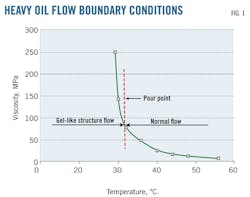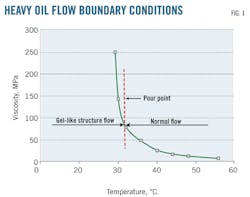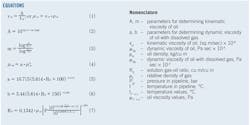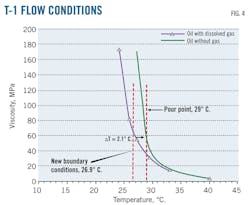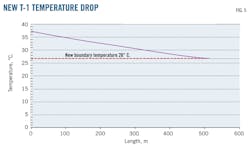Lowest possible flow temp. offers savings vs. pour point
Dusan Danilovic, Vesna Karovic-Maricic, Dejan Ivezic, Veselin Batalovic, Marija Zivkovic, Miroslav Crnogorac
University of Belgrade
Serbia
Leaving produced gas entrained in heavy oil pipelines reduces energy costs by allowing the oil to flow at a lower temperature. This article analyzes boundary heavy oil flow conditions, defining the minimum possible flow temperature. Pipeline design for heavy oil transportation must not be done exclusively on the basis of the oil's pour point value, but instead by determining the lowest possible flow temperature.
This method achieved energy savings for two well pipelines in Serbia's Turija North oil field of 5.4 and 9.5%, with research suggesting an average savings for the technique of about 5%.
Background
Heavy oil characteristics such as high pour point, paraffin deposition, and higher viscosity, cause problems in production systems, particularly wellbore and pipeline,1-4 and increase production costs.5-6 Most solutions apply thermal or chemical methods.7-8 Thermal methods include heating by electric heaters or heating the whole length of a pipeline with heating cable. Chemical methods use additives for lowering pour point temperature, improving flow characteristics, or both.
The most common solutions for transporting heavy oil produced in Serbia involve heated oil. An electric heater at the beginning of older pipelines allows for transport to downstream gathering stations. Pipelines of larger length or low flow rate will typically have another electric heater 400-600 m from the first. Transporting oil in a heated state requires the pipeline be insulated.5 Fluid heating by heating cable occurs in new or reconstructed pipelines.
The common point in thermal and chemical methods' application is that heavy oil flow must occur at temperatures above pour point. The heating system or additives are designed according to that requirement.
Most of the research on this topic has been based on laboratory simulation of flow conditions and paraffin deposition.9-10 Experimental testing of paraffin deposition has shown its influence on flow reduction.11 The intensity of deposition's dependence on pour point temperature has also been studied.2 Researchers have also examined paraffin deposition as a function of time under different conditions.12
Research into flow conditions for crude oil produced at the Turija North field has also occurred,3 13 with the influence of paraffin content on the rheological properties of fluid analyzed. Domestic Serbian crude oil, due to its high paraffin content, and sometimes asphaltene, behaves not only as a Newtonian fluid, but also as a pseudoplastic, or even as a Bigham fluid.14-15 These fluids often have a high pour point, sometimes above 30° C.
Heavy oil flow is possible in practice at lower temperatures than pour point.13 Aside from the cooling achieved during fluid flow through the pipeline, fluid composition also affects flow characteristics. Fluid can be a multiphase mixture of oil and gas, or oil, gas, and reservoir water.16-17 Dissolved gas in oil can improve flow and reduce heavy oil's viscosity.
This article will present a precise determination of the minimum temperature that allows the flow of heavy oil, allowing heating systems to work at lower temperatures and yielding energy savings. Such an approach would also reduce the amount of additives needed for lowering pour point, further reducing costs.
Methodology
Viscosity changes can determine the critical, or lowest, temperature at which the oil will flow (Fig. 1). There is a large increase in viscosity at temperatures about 3-5° C. above pour point. At these temperatures oil behaves like a non-Newtonian fluid. Pour point can be considered a boundary temperature for normal oil flow. At lower temperatures, oil tends to thicken and take on a gel-like structure, further disabling its flow.13 18-19
Previous practice had heavy oil pipelines designed so that the minimum flow temperature equaled pour point. The flow of heavy oil, however, is possible at temperatures below pour point.13
During the oil flow a certain amount of gas dissolves into the oil with the balance remaining free. The amount of dissolved gas depends on pressure and temperature. Dissolved gas in oil reduces viscosity and improves flow conditions. Higher pressure increases the dissolved gas amount, allowing flow below the oil's pour point. Fig. 2 presents the viscosity curve for heavy oil without dissolved gas.
Either laboratory measurements or Equation 1 can determine viscosity change. Parameters A and m are calculated in Equations 2 and 3. Determining the minimum (boundary) temperature conditions of heavy oil flow (with dissolved gas) through a pipeline requires calculating its viscosity by Chew and Connally, Equation 4, with parameters expressed by Equations 5 and 6. Equation 7 determines the amount of dissolved gas.
Oil viscosity's dependence on the amount of dissolved gas can be determined on the basis of known in-pipeline pressure and temperature using previous equations. A sudden increase in viscosity indicates flow boundary conditions. Fig. 2 presents the viscosity curve for oil with dissolved gas and the new boundary conditions of flow. Temperature change (ΔT) defines the flow boundary condition change under the influence of dissolved gas, quantifying the phenomenon as observed in practice.
The pipeline heating system can be designed for a lower working temperature, ΔT, than the existing one, resulting in reduced electricity consumption and more efficient heavy oil production. Presented methodology shows that the design of a pipeline for heavy oil transportation not only must be done on the basis of pour point, but also by determining the lowest possible flow temperature, laboratory measurements of pour point not taking into account dissolved gas's influence.
Results
The Turija North oil field provides an example for analysis of temperature flow conditions of heavy oil when the fluid heating system is redefined and energy consumption reduced. This field produces heavy oil from 60 wells and has four gathering stations. Each well is connected to a gathering station by its own pipeline. The wells produce between 2 and 23.8 cu m/day at a gas-oil ratio (GOR) of 30-50 cu m/cu m and produced water ranging from 5 to 70%. Average pour point is around 33° C., but reaches as high as 40° C. for some wells. Average paraffin content is about 17%, with values in the range of 5-25%. The oil has unfavorable rheological characteristics.
Two typical well pipelines at the Turija North oil field, T-1 and T-2, provide the basis for evaluation. Table 1 gives basic parameters of these well's pipelines. The pipelines are insulated by polyurethane foam with thermal conductivity of λ=0.03 W/m °C. and 50-mm thickness. A 9-kw electro induction heater installed at the beginning of the pipeline provides heat, with the minimum soil temperature 2° C.
Pipeline T-1
The oil pour point is 29° C. Fig. 3 presents the pipeline's calculated temperature drop.20
With the fluid flow temperature along the entire pipeline greater than pour point, the projected value of fluid heating temperature at the beginning of the pipeline (40° C.) allows safe and efficient oil flow of 20 cu m/day.
Laboratory measurements determine viscosity of oil produced by well T-1 (Fig. 4). Fig. 4 also shows the pour point representing boundary flow conditions for oil without dissolved gas. Equation 4 calculates the viscosity curve for oil with dissolved gas.21 The presented methodology defines new boundary flow conditions corresponding to 26.1° C. The oil flow minimum temperature cannot be less than this value.
The operator can reduce the 40° C. heating temperature at the beginning of the pipeline. Calculations show that 38.1° C. at the beginning of the line will maintain a temperature above 26.9° C. at line-end (Fig. 5).20 Instead of operating at 7.99 kw/hr, the heater could run at 7.23 kw/hr and achieve the new target temperature of 38.1° C., providing energy savings of about 9.5% (Table 2).
The results for this well pipeline are higher than average because the well has a high GOR (50 cu m/cu m) and greater oil production than the other wells at this field.
Pipeline T-2
T-2 oil's pour point is 31.9° C. The heating temperature at the beginning of the pipeline is 44° C. With the previous methodology, Fig. 6 shows measured values of oil viscosity and calculated values for oil with dissolved gas. Dissolved gas in the oil dropped pour point 1.6° C., to 30.3° C.
Reducing heating temperature by 1.3° C. in this pipeline will reduce energy consumption by about 5.4% (Table 3).21 The degree of heating temperature reduction depends directly on the amount of dissolved gas in the oil; the larger the amount of dissolved gas the greater the reduction.
Acknowledgment
This article is the result of a project financed by the Ministry of Science and Technological Development in Serbia (Project No. 33001).
References
1. Tinsley, J.F., and Prudhomme, R.K., "Deposition Apparatus to Study the Effects of Polymers and Asphaltenes Upon," Journal of Petroleum Science and Engineering, Vol. 72, No. 1-2, May 2010, pp. 166-174.
2. Venkatesana, R., Nagarajanb, N.R., Pasoa, K., Yic, Y.B., Sastryc, A.M., and Foglera, H.S., "The Strength of Paraffin Gels Formed Under Static and Flow Conditions," Chemical Engineering Science, Vol. 60, No. 13, July 2005, pp. 3587-3598.
3. Danilovic, D., Karovic-Maricic, V., Secerov, R., Ivezic, D., and Zivkovic, M., "Laboratory Testing and Simulation of the Paraffin Deposition in Turija Field Oil Well in Vojvodina," Hemijska Industrija, Vol. 65, No. 3, March 2011, pp. 249-256.
4. Danilovic, D., Karovic-Maricic, V., and Cokorilo, V., "Solving Paraffin Deposition Problem in Tubing by Heating Cable Application," Thermal Science, Vol. 14, No. 1, January 2010, pp. 247-253.
5. Danilovic, D., "Optimization of Small Oil Field Production Applying the Model of Integral Management," PhD thesis, University of Belgrade, Faculty of Mining and Geology, p. 161, 2001.
6. Danilovic, D., Karovic-Maricic, V., Batalovic, V., and Lekovic, B. "Device for More Efficient Production of Heavy Oil," Chemical Engineering Research and Design, Vol. 90, No. 2, February 2011, pp. 238-242.
7. Wang, J. and Dong, M., "Optimum Effective Viscosity of Polymer Solution for Improving Heavy Oil Recovery," Journal of Petroleum Science and Engineering, Vol. 67, No. 3-4, August 2009, pp. 155–158.
8. Hasan, S.W., Ghannam, M.T., and Esmail, N., "Heavy Crude Oil Viscosity Reduction and Rheology for Pipeline Transportation," Fuel, Vol. 89, No. 6, June 2010, pp. 1,095–1,100.
9. Luo, P., Yang, C., and Gu, Y., "Enhanced Solvent Dissolution Into In-Situ Upgraded Heavy Oil Under Different Pressures," Fluid Phase Equilibria, Vol. 252, No. 1-2, March 2007, pp. 143–151.
10. Ghannam, M.T., Hasan, S.W., Abu-Jdayil, B., and Esmail, N., "Rheological Properties of Heavy & Light Crude Oil Mixtures for Improving Flowability," Journal of Petroleum Science and Engineering, Vol. 81, No. 1-2, January 2012, pp. 122–128.
11. Kane, M., Djabourov, M., Volle, J.L., Lechaire, J.P., and Frebourg, G., "Morphology of Paraffin Crystals in Waxy Crude Oils Cooled in Quiescent Conditions and Under Flow," Fuel, Vol. 82, No. 2, January 2003, pp. 127–135.
12. Ismail, L., Westacott, R.E., and Ni, X., "On the Effect of Wax Content on Paraffin Wax Deposition in a Batch Oscillatory Baffled Tube Apparatus," Chemical Engineering Journal, Vol. 137, No. 2, April 2008, pp. 205–213.
13. Danilovic, D., "Possibilities of More Effective Paraffin Oil Production on the Fields of Oil Industry of Serbia," MSc thesis, University of Belgrade, Faculty of mining and geology, 1997, p. 168.
14. Secerov, R., Bjelovic, Z., and Sokolovic, S., "The Effect of Paraffin on the Rheology Model - Oil," Hemijska Industrija, Vol. 60, No. 1-2, June 2006, pp. 10-14.
15. Šecerov, R., Sokolovic, S., Vulic, T., and Pekaric, N., "Effect of Pulsed Electromagnetic Field on Crude Oil Rheology," Industrial & Engineering Chemistry Research, Vol. 37, No. 12, December 1998, pp. 4828-4834.
16. Spedding, P.L., Benard, E., and Crawford, N.M., "Fluid Flow Through a Vertical to Horizontal 90° Elbow Bend III Three-Phase Flow," Experimental Thermal and Fluid Science, Vol. 32, No. 3, March 2008, pp. 827-843.
17. Daas, M., and Bleyle, D., "Computational and Experimental Investigation of the Drag Reduction and the Components of Pressure Drop in Horizontal Slug Flow Using Liquids of Different Viscosities," Experimental Thermal and Fluid Science, Vol. 30, No. 4, April 2006, pp. 307-317.
18. Hinkle, A., Shin, E.J., Liberatore, M.W., Herring, A.M., and Batzle, M., "Correlating the Chemical and Physical Properties of a Set of Heavy Oils From Around the World," Fuel, Vol. 87, No. 13-14, October 2008, pp. 3065–3070.
19. Akin, S. and Kovscek, R.K., "Heavy-Oil Solution Gas Drive: A Laboratory Study," Journal of Petroleum Science and Engineering, Vol. 35, No. 1-2, July 2002, pp. 33–48.
20. Petroleum Industry of Serbia, Novi Sad, 2011.
21. PipeSim manual, Schlumberger, Logelco Inc.
The authors
Dusan Danilovic ([email protected]) is associate professor and head of the petroleum engineering department at the University of Belgrade–faculty of mining and geology. He has worked as a consultant for the Ministry of Mining and Energy of Republic of Serbia, Petroleum Industry of Serbia, South East Europe Consultants Ltd., and PM Lucas, among others. Danilovic is also involved in many projects addressing production engineering and the rational use and saving of energy. He is a member of the Serbian Oil Association and holds BS, MS, and Ph.D degrees in petroleum engineering from the University of Belgrade.
Vesna Karovic-Maricic ([email protected]) is an assistant professor at the department of petroleum engineering, faculty of mining and geology, University of Belgrade. She has extensive experience in reservoir engineering and reservoir management research and teaching. Karovic-Maricic holds BS, MS, and Ph.D degrees in petroleum engineering from the University of Belgrade.
Dejan Ivezic ([email protected]) is associate professor at University of Belgrade–faculty of mining and geology. He also serves as manager of the Center for Energy. He is a member of the Serbian Energy Specialist and Gas Associations and holds BS, MS, and Ph.D degrees in mechanical engineering from the University of Belgrade.
Veselin Batalovic ([email protected]) is professor and head of the department of mechanical engineering and thermodynamics at University of Belgrade. He works as a researcher on projects for the Ministry of Mining and Technology of the Serbian Republic and holds BS, MS, and Ph.D degrees in petroleum engineering from the University of Belgrade.
Marija Zivkovic ([email protected]) is assistant professor at University of Belgrade – faculty of mining and geology. She is also involved in many projects involving the rational use and saving of energy. Zivkovic is a member of Serbian Energy Specialist and Gas Associations and holds BS, MS, and Ph.D degrees in mechanical engineering from the University of Belgrade.
Miroslav Crnogorac ([email protected]) is a PhD student at the University of Belgrade, faculty of mining and geology, department of petroleum engineering. He holds BS and MS degrees in petroleum engineering from the University of Belgrade.
